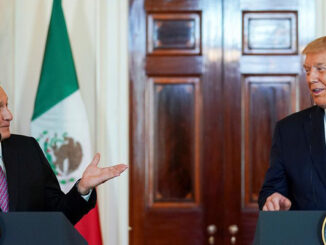
WSJ, Editorial
Every nation has its own political third-rail. In Mexico, it’s oil. It’s been that way since 1938, when a socialist president named Lázaro Cárdenas nationalized the industry and made Petróleos Mexicanos, or Pemex, nearly synonymous with patriotism.
This is what makes President Enrique Peña Nieto’s double-barreled proposal on Monday to open Mexico’s vast oil fields to private investment and end the monopoly of Mexico’s Federal Electricity Commission (FEC) so extraordinary. If the constitutional amendments he proposed make their way through Congress, they will—warts and all—mark a milestone in the country’s economic modernization not seen since the 1994 North American Free Trade Agreement.
Like its American neighbors in the Gulf of Mexico and Texas, Mexico sits on huge reservoirs of oil and gas, estimated at 87 billion barrels. But bringing that wealth to the surface takes the right business model and the right technology, both in short supply at Pemex. The company pumped just 2.5 million barrels per day in 2012, down from 3.4 million in 2003. Because Pemex royalties and taxes amount to more than a third of federal revenues, waning output also has worrying implications for the federal fisc.
Monopoly power is at the heart of Mexico’s energy troubles and it’s hardly a secret. Though company officials complain about scarce resources, “public investment has increased seven-fold in the last 15 years to $20 billion annually,” as energy minister Pedro Joaquín Coldwell noted Monday. As a state-owned company with a powerful labor union, “investment” spending at Pemex is often, well, suboptimal.
Click on Video to watch
Mr. Peña Nieto’s proposal doesn’t go as far as it might to solve Mexico’s oil woes, and it certainly doesn’t privatize Pemex. It doesn’t even give investors ownership of a drop of Mexican oil.
Instead, the bill allows foreign and domestic investors to become partners with Pemex in exploration and production. Those partners would take their profits not in oil but in the cash equivalent of what they pump. Whether that’s enough of an incentive to entice a Chevron or a Shell will then depend on secondary legislation, particularly on contract terms and taxes. It would be a shame if Mr. Peña Nieto and his allies in Congress fail to follow through here, but at least their political incentive is to make the reform a success.
As for the electricity portion of the bill, Mr. Peña Nieto is picking up on the efforts of his predecessor Ernesto Zedillo (1994-2000) to allow private companies to generate and sell electricity directly to consumers; for now, those companies must first sell electricity to the FEC. That earlier effort failed on account of the political opposition of Felipe Calderón, then a leader of the opposition PAN party and later Mexico’s president. But now the PAN is on board for Mr. Peña Nieto reforms, no small achievement for the young president and crucial for Mexico’s bid to become a global manufacturing powerhouse.
None of this is to say that Mr. Peña Nieto doesn’t face political obstacles. Former leftist presidential candidate Andres Manuel López Obrador flatly opposes any liberalization and has promised to lead the faithful into the streets—a tactic that nearly brought Mexico City to a standstill after Mr. López Obrador lost his first presidential race in 2006.
Yet the fact that Mr. Peña Nieto has been able to grip the energy rail without paying for it with his political life is another demonstration of how far Mexico has come in recent years—and of how ambitious Mexicans are to keep going.
A version of this article appeared The Wall Street Journal.



